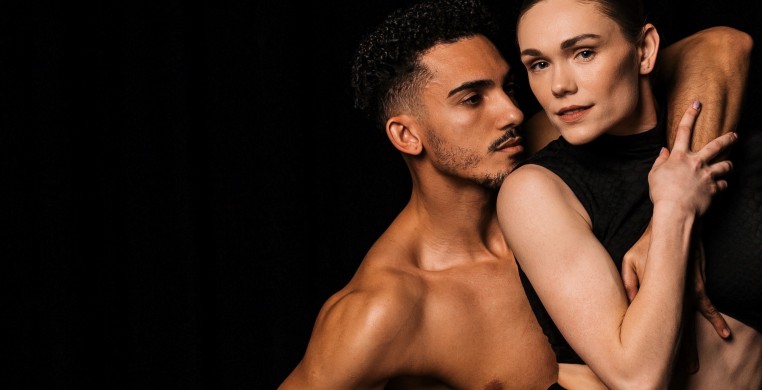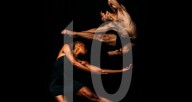A lot can happen in a decade. If you are dancer, choreographer and Artistic Director of Visceral Dance Chicago Nick Pupillo, a lot has changed! The Visceral dance studio moved locations from a grey, brick building on the corner of Elston and Diversey to a new studio with a sleek black exterior and brand-new studios, including one that converts to a state-of-the-art performance venue named after famous Chicago dance writer Ann Barzel. The in-house dance company of the same name has also gone through changes, which Pupillo plans to explore in “SpringTEN” on April 28 at the Harris Theatre.
In celebration of their 10-year anniversary as a company, “SpringTEN” is bookended by the company’s very first work, “Impetere” (2013), and their most recent, “Lotus,” both by Pupillo. Other works in the program include Pupillo’s dark, sexy duet, “Keep,” fan-favorite “Ruff Celts” by Irish dancer, choreographer and ballet director, Marguerite Donlon, and “Name It” by former dancer and rehearsal director of the Batsheva Dance Company, Danielle Agami.
“Impetere means ‘driving force' in Latin,” Pupillo said in an interview with See Chicago Dance, “and I want people to see Visceral in that way, as a driving force, cutting edge, but then I want people to see them as human beings, as people you can relate to and connect with.”
There are several themes that recur in much of Pupillo’s work, foremost that of using the individual strengths of the dancers to their full advantage. “I’ll use the dancer’s artistic voice and intertwine moments together. They train hard, they work hard and have that physicality that we are known for. I’m drawn to who they are as individuals and who they are as artists. I’m interested in what they have to say and I want the audience to see us as a company, but also to see them individually as artists.”
Braeden Barnes, one of the two dancers in “Keep,” echoes Pupillo’s sentiments. “I was really drawn to the company, how they found this niche in Chicago dance, how they keep evolving and exploring different choreographers, but also a focus on the individual,” said Barnes. “I started to see myself as an artist and an individual, and I think that’s what Nick does, he really tries to give and leave space for all the dancers he hires into the company.” Barnes is retiring from the company after six seasons and is still enamored with Pupillo’s approach to dance. “Nick’s movements are something that you feel," said Barnes. “A lot of times we watch dance and we can’t put into words how we feel, but with Nick’s choreography you feel something that resonates with you for a long time. It really helped me grow not just as an artist, but as a person.”
For his final performance with Visceral, Barnes will dance as half of a duo in “Keep,” a duet in which two partners stay in constant physical contact to emphasize feelings of possession and obsession. “It’s a very special piece for me. It comes from this place of loss and saving; you feel like you’re at this point where you need some support and at the end of the duet you find that support.”
See Chicago Dance was invited to a sneak peak of “Lotus,” a piece that contains themes that recur throughout Pupillo’s body of work. The first theme has already been touched on, a focus on the dancers; in multiple sections, different couples play off each other, while groups of eight or ten position themselves in the background, slowly melting into the foreground via slow walks, unnoticed while the attention is on the featured dancers in front. Each duet is different. They create small vignettes that showcase the individual strengths of dancers, creating hybrids as their unique personalities merge into one.

Another theme is rhythm and phrasing. Throughout “Lotus” there is a constant restraint of movement—like a rubber band being slowly pulled taught—and then a quick release, a modulation of tempo creates a constant cycle of tension and release. Other sections keep a stricter account of timing, with the same movement rippling through the dancers at different times creating a wave-like effect.
Speaking of effects, a third theme is that of physicality and visual formations like optical illusions that are striking and pleasing to the eye. Twice, there is an effect of the company creating a chain with the dancers linked at the arms, swaying, twisting and rattling like being shaken by a giant, unseen hand.
As mentioned, there are two works by guest artists, especially curated for this 10-year anniversary show. Marguerite Donlon’s “Ruff Celts” was chosen for its lightheartedness, which contrasts with the otherwise heavy material in the show. Women in black leotards and men in black kilts race through a shifting series of rough and tumble maneuvers with elements of humor and slapstick —sometimes they’re brash Celtic warriors, other times interlocked Greco-Roman wrestlers. “The thing about Marguerite,” said Pupillo, “is that when I was looking into her work with Hubbard Street, I was finding that ballet technique foundation, but she deconstructs it and makes it quirky and unique. It works with the dancers’ base technique, but has this fun, playfulness to it. And I think for her she has this dry sense of humor that’s super fun, and there are certain gestures in that piece that the audience will always remember.”
The other guest piece is a premier by Danielle Agami, titled “Name It,” with a heavy influence from Gaga, a style of movement that uses slow, delicate gestures (but can still pack a punch!) developed by Ohad Naharin and learned by Agami during her time with Batsheva. Visceral dancer Meagan Cubides explained Agami’s work, saying that “There is a lot of influence from the Gaga technique in terms of how grounded you are, and everything becoming internal rather than external. You won’t see a lot of ballet elements right away. The goal of the piece is to be more internal; we’re not performing for the audience but are inviting the audience into the work.”
“Name It” was composed using a lens different from those shared by most American dancers and audiences, based on Agami’s experience as an Israeli. “[Agami] brings culture and politics into her work,” said Pupillo, “and this piece pushes a lot of boundaries. It asks a lot of questions about what satisfies us as Americans compared to her Israeli culture. But there is a range to the piece, and it ends with an Elvis Presley song.”
After ten years, Visceral Dance Chicago is as dynamic as ever, and where they are now is made even more impressive when you’ve seen where they’ve been, which you can do by attending “SpringTEN.”
-----------
“SpringTEN” is presented by Visceral Dance Chicago at the Harris Theatre, 205 E. Randolph, on April 28. Tickets are $16-$75 and are available by visiting visceraldance.com.



